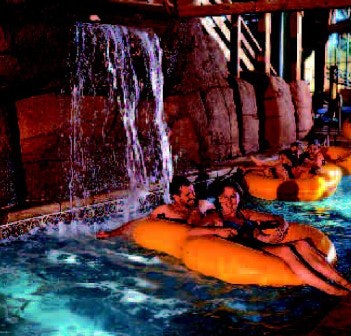
It used to be that consumers had to go to Disney or Sea World to see elaborate, authentic-looking, artificial-rock water environments. But over the last 20 years or so, as the popularity of resort-, hotel/motel- and destination waterparks has grown, homeowners have had more opportunities to ponder the idea of having a little bit of waterpark resort in their own backyards.
According to the World Waterpark Association, about 73 million people visited the more than 1,000 waterparks in North America during the 2004 season. That represents a 3 to 5 percent average attendance growth over the last five years. At the Wisconsin Dells, the concensus waterpark capital of the world, visitor spending in off-peak months (September through April) went from $88 million in 1993 to almost $500 million in 2004, an increase the Wisconsin Dells Visitor and Convention Bureau attributes to the addition of indoor waterparks — now numbering 18 in the Dells.
Given homeowners' growing exposure to tropical-style retreats, it's probably not a coincidence that more of them are asking for the "resort-style" pools exemplified by builders like Ozzie Kraft Ent., in Las Vegas, with hand carved, fabricated rock, dramatic waterfalls, grottoes and caves. But few homeowners can afford the price of admission for a custom backyard resort pool, so the marketplace is starting to fill the gap with a dazzling array of modular, smaller-scale, artificial-rock water features that allow builders to give their clients a touch of tropical resort without buying the entire island.
"For the last 20 years people have been seeing this, through their travels, and vacations, hotels they stay at, theme parks they go to, the water parks they go to, the zoos they go to, museums, almost everything is themed in some way," says Jeff Jarboe, vice president and partner in Replications Unlimited, an artificial rockscape manufacturer that has recently turned its attention to the residential market. "So people used to think artifical rock was not as nice nor as real, and what we created is so close to real, it becomes nice and acceptable."
The more consumers are exposed to rocky-themed environments, the less of a leap it is to imagine it in their own homes. "They think, 'Hey, that would be neat to have something like that in my backyard.' So we've gone from the commercial part and created a new company to hit the residential and retail part of it."
Jarboe observes that nearly every pool that's built today has some sort of added waterplay. "It's a very hot trend. There are tens of thousands of in-ground swimming pools across the country, and there are very few pools that don't have some sort of water feature attached, nowadays." he says. "Whether it's an artificial rock waterfall, or rock structure of some sort, or even a non-rock item, a waterfall, sheer-descent type thing. There's no question, there's probably not a pool put in today, unless people are really old-fashioned, that they're not going to have [some kind of moving water] with the pool."
Mike Webb of Pentair watches the market closely as he develops new products for the pool equipment giant. "I think that there's a lot more products that could be done, that are not being done today," he says. "I think there are a lot more products that could be integrated into the pool. I think the whole water feature aspect of a pool — both in terms of the enjoyment visually and also the play aspect — is going to grow as manufacturers begin to offer more things, providing a product that's easy to install, with suggestions for installation and service."
What's Out There?
Artificial rock water features come in a range of sizes, prices, materials, designs, detail and complexities. And there's a surprising number of niches and price points within the broad category. At the low end of the scale are a variety of self-contained "plugn-play" kits that come from the bigbox home and garden centers. At the highest end of the scale are projects hand built from natural rock and probably designed by a landscape architect. These types of projects run to the hundreds of thousands of dollars. Somewhere in the middle of those extremes is where modular or kit artificial rock water features reside.
Mike Reinwald, general manager of Rock and Water Creations in Fillmore, Calif., says his company has introduced a product to serve that market. "I think there are people out there who are not so much interested in the really small water features that you can get from Home Depot, they want something larger, more prominent, that they could put on a pond, or the pool. It's not so small that homeowners can do it themselves — you really do need a contractor to put it in — but it does fill that niche where people want something but they can't necessarily afford something huge," he says. "A lot of the contractors have them in their portfolios, it fills that niche, when a homeowner wants a waterfall, but not a huge one."
Mark Toler of Rico Rock, with offices in South Dakota, California and Florida, deftly describes an emerging market: "There was a market that was ignored for a long time, and that's the $2,000 to $3,000 waterfall that's above and beyond the quality of the fiberglass and the foam urethane composites that are out there," says Toler. "There's a range there, where people are willing to pay a little more, and it hasn't really been tapped into, because our contractors usually don't want to go out for anything less than $4,000 to $5,000, so when somebody had a smaller budget but was still above the low-end options in the market, they were just kind of ignored."
Reality Rocks
The advantages to an artifical rock water feature are numerous. For the most fidelity, artificial rocks are manufactured from molds taken from the real thing, so a fake or plastic look is no longer an objection for most consumers.
"The molds are taken off of actual rocks and cliffs. So that's where the realism and the small detail comes from," says Reinwald.
Once the mold is taken, most builder-quality features are made from some sort of rock-like substance, usually fiber-reinforced concrete that is sprayed into a mold, and/or formed over an armature, allowing for a shell of very rock-like cementitious material, but with much less weight.
Other companies use non-cementitious materials. For example, Replications Unlimited makes its product with a proprietary material they call Urestone. The formulation is secret, but they say it's a polyurethane plastic system combined with a high performance coloring system; the same type of material as a high impact automotive bumper.
Whether concrete or composite, the modular waterfalls offer major advantages over site-built real-rock waterfalls. They are lighter, easier to install and less expensive.
"In the past, [builders] subbed it all out, because it wasn't their specialty," says Jarboe. "So then the sub deals with it for another couple of weeks, and the money is delayed, and then what they find with the real stone, they might not get the sheet liner right, and it might leak behind the pool, and there can be sediment from real rocks that's continually in the pool and you have to keep vacuuming it, and on and on.
"So with a modular system, they put it in, immediately they are done, they get paid, there's no delay, there's no mess, no deterioration, no leaking behind something, no problems created by it, and here's a key point: the pool contractors can do it themselves; they don't have to sub it out or hire someone else to do it. If they're not doing it themselves, they're losing profit, not making the same margin, so they're happy to have another choice."
Reinwald points to the time savings for a prefabricated feature. "I think the contractor can get it done in a twoday process. Whereas if they're [site building], it's going to be at least a couple of weeks."
Jarboe says once the site is prepared, his product "can be installed in a matter of minutes versus days. That's important when the contractors are trying to finish a pool and get their money, they don't have to spend days and weeks on the water feature."
Rock Is Hard
But all is not sunshine and umbrella drinks in the world of backyard resorts. Some one-piece waterfalls are so simple that do-it-yourselfers are tempted to, well, do it themselves. The types of one piece, plug-n-play features that homeowners can buy at Home Depot or Wal-Mart are in a price range such that they probably do not pose competition to pool builders. However, because these types of features are so popular, less skilled workers are getting into the business, and sometimes the results are disastrous.
"I think they sometimes allow homeowners to do it themselves, as opposed to someone who's skilled," says Jeff Ingrassia of AquaFX by Island Care, Mt. Sinai, N.Y. "With the smaller stuff, you get other guys doing it —you'll get your local landscaper doing it, and they'll still run into problems.
"I'll be honest with you — about 50 percent of our work comes from redos from other contractors who walk off jobs, or the client is unhappy with unrealistic jobs. So when you deal with water features 100 percent of the time, you'd be surprised some of the projects I have to strip down that people have already invested maybe 3 or 4 thousand," says Ingrassia.
One manufacturer thinks they've come up with a way to begin to address that problem. "We don't want to lose our dealers or upset the pool companies, either," says Toler. "So we're starting to make that switch, to make it easy enough that the homeowner or the handyman could buy a permanent waterfall from us and have that quality of a product, not have to settle for something cheap that will fall apart in a couple of years. And not have to go for something bigger that's out of their budget."
But this product doesn't bypass RicoRock builders. "It's a low enough price range that it's not lucrative for a builder to do," says Toler. "So where builders will have an option is to collect a commission on this product. If a homeowner calls us and wants that [do-it-yourself] waterfall, and we have someone in the area, we can ship it to them, because they have the facility to receive it, the homeowner is going to pick it up, and the builder can collect the commission on it. It was a market [builders] were ignoring anyway, and now they have another little profit center. It's kind of a new line for some of them."











































